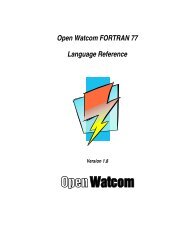Relocatable Object Module Format (OMF) Specification
Relocatable Object Module Format (OMF) Specification
Relocatable Object Module Format (OMF) Specification
Create successful ePaper yourself
Turn your PDF publications into a flip-book with our unique Google optimized e-Paper software.
<strong>Relocatable</strong> <strong>Object</strong> <strong>Module</strong> <strong>Format</strong><br />
6 Not supported.<br />
7 Not defined.<br />
The new values for 32-bit linkers are A=4 and A=5. Double word alignment is expected to be<br />
useful as 32-bit memory paths become more prevalent. Page-align is useful for certain<br />
hardware-defined items (such as page tables) and error avoidance.<br />
Note: If A=0, the conditional Frame Number and Offset fields are present and<br />
indicate the starting address of the absolute segment. Microsoft LINK ignores the<br />
Offset field.<br />
Conflict: The original Intel 8086 specification included additional segmentalignment<br />
values not supported by Microsoft; alignment 5 now conflicts with the<br />
following Microsoft LINK extensions:<br />
5 "unnamed absolute portion of memory address space"<br />
6 "load-time locatable (LTL), paragraph aligned if not part of any group"<br />
C<br />
B<br />
P<br />
Combination<br />
This 3-bit field describes how the linker can combine the segment with other segments. Under<br />
MS-DOS, segments with the same name and class can be combined in two ways: they can be<br />
concatenated to form one logical segment, or they can be overlapped. In the latter case, they<br />
have either the same starting address or the same ending address, and they describe a common<br />
area in memory. Values for the C field are:<br />
0 Private. Do not combine with any other program segment.<br />
1 Reserved.<br />
2 Public. Combine by appending at an offset that meets the alignment requirement.<br />
3 Reserved.<br />
4 Same as C=2 (public).<br />
5 Stack. Combine as for C=2. This combine type forces byte alignment.<br />
6 Common. Combine by overlay using maximum size.<br />
7 Same as C=2 (public).<br />
Conflict: The original Intel 8086 specification lists C=1 as Common, not C=6.<br />
Big<br />
Used as the high-order bit of the Segment Length field. If this bit is set, the segment length value<br />
must be 0. If the record type is 98H and this bit is set, the segment is exactly 64K long. If the<br />
record type is 99H and this bit is set, the segment is exactly 2 32 bytes or 4 GB long.<br />
This bit corresponds to the bit field for segment descriptors, known as the B bit for data segments<br />
and the D bit for code segments in Intel documentation.<br />
If 0, then the segment is no larger than 64K (if data), and 16-bit addressing and operands are the<br />
default (if code). This is a Use16 segment.<br />
If nonzero, then the segment may be larger than 64K (if data), and 32-bit addressing and<br />
operands are the default (if code). This is a Use32 segment.<br />
Note: This is the only method for defining Use32 segments in the TIS <strong>OMF</strong>.<br />
38 <strong>OMF</strong> <strong>Specification</strong>, Version 1.1 Tool Interface Standards (TIS)
















